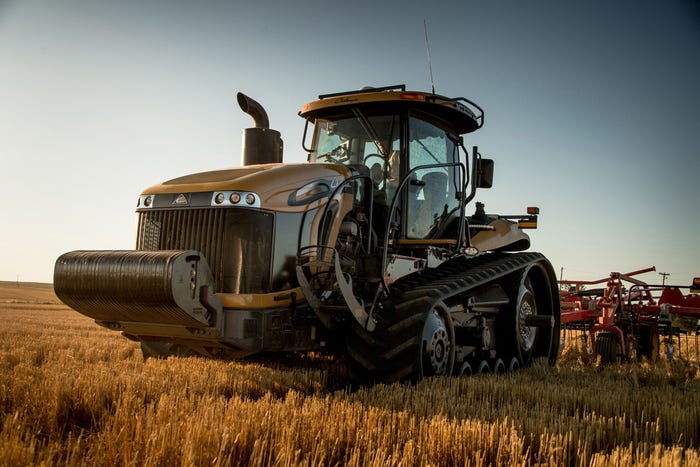March 26, 2015

Forget the arguments about which is better—tires or tracks on farm tractors. Both have their advantages depending on soil types and ground conditions, leaving much of the decision to price and brand preference.
But extremely wet weather conditions over the past few years combined with an ever increasing focus towards maximizing yield have given tracks some renewed attention, putting a new spin on the age-old debate.
OEMs report a pique in interest the past two years, driven by muddy conditions that kept farmers out of the fields for fear of getting stuck. Tracks can work well even when the ground is wet because they have a bigger footprint compared to wheels.
“Farmers are looking to buy tracked vehicles as an insurance policy for next year should the same weather repeat itself,” says Roger Lewno, Case IH HHP (High Horsepower) marketing manager specialist. “Tracks can give you early access to fields so you get fieldwork done on time.”
Tracks account for less than 10% of the tire and track agricultural market, but account for as much as 30% of large horsepower tractors. As such farmers are looking to have more options than ever this year with new players and more configurations. With tracks commanding a 14 to 21 percent premium over wheels, it pays to do some homework.
Know your options
Making a tracked vehicle is more than slapping a belt around some rollers. Each company has its own configuration designed specifically for their vehicles.
Camoplast makes rubber belts and track systems for almost all of the OEMs. Their partners include Agco, Case IH, Claas, John Deere, New Holland, and Versatile amongst others.
We asked Camoplast Product Line Director Martin Lunkenbein how the different systems work and points to consider when buying.
--Drive system: Tracks use one of two types of drive systems. One system, called friction drive, uses the tension or friction between the track and drive wheel to move the vehicle forward. This system is called friction drive. John Deere and Agco use this system.
“Positive drive uses more of a gear approach, where a sprocket engages the drive lug,” Lunkenbein says. “The final drive is what vehicles the machine forward. It essentially works the same way as a tire.” This drive system is common in four-track vehicles including Case IH, New Holland and Versatile. Positive drive, typically a four-track system, lets you convert a machine from wheel to track because the four tracks fit the same space as the wheels. (Note: Camoplast offers Conversion Track System (CTS) fitment kits for wheeled tractors or combines and a Trailed Track System (TTS) for trailed implements.
Camoplast makes both friction-drive and positive systems, and Lunkenbein says both systems work well, as long as the track and undercarriage are integrated properly. “For example, with friction drive, belt tension must be properly adjusted and managed for peak performance. The same is true with positive drive. If the track doesn’t engage properly in the sprocket, then track life will be affected.
--Number of tracks: The most visible difference is the number of tracks. Deere and Challenger use a two track system on their tractors. Case IH, New Holland and Versatile use four. Case IH and New Holland also offer a hybrid track system with tires in front and tracks in back.
From our perspective, one is not better than the other. It’s really it’s a matter of the farmers preference and how the OEs put it together,” concludes Lunkenbein.
--Attack angle: Also important is how the tracks transition between being off the ground to being on the ground, also called the “attack angle.” Ideally, the drive wheel and idler wheel will be slightly higher than the midrollers so that the track approaches the ground at an angle. “If all the wheels are touching the ground at the same time, you will scrape the treadbar and wear out the track really quickly if you are on the road,” Lunkenbein says.
--Tread bar angle: Another difference is the geometry of the tread bar, which needs to fit the application. “For example, for high traction heavy tillage applications, we might use a bigger tread bar on top to put power to the ground. For a more delicate application such as a planter, you want almost no tread bar because all you’re trying to do is better distribute weight to the ground without adding traction.”
--Other details: After considering those things, the rest is in the details. Variations include the size and number of drive lugs, size of the drive wheel, the position and number of midrollers and idler wheels, width of the track, and bogie design.
“It’s up to the manufacturer to decide which system to go with,” Lunkenbein says. “The decision for buyers will often come down to the applications they are running, brand loyalty and dealer location.”
Now, here’s a brief look at the track systems offered by the major tractor OEMs.
You might also like these galleries:
Like what you’re reading? Subscribe to Farm Industry News Now e-newsletter to get the latest news and more straight to your inbox twice weekly.
About the Author(s)
You May Also Like




